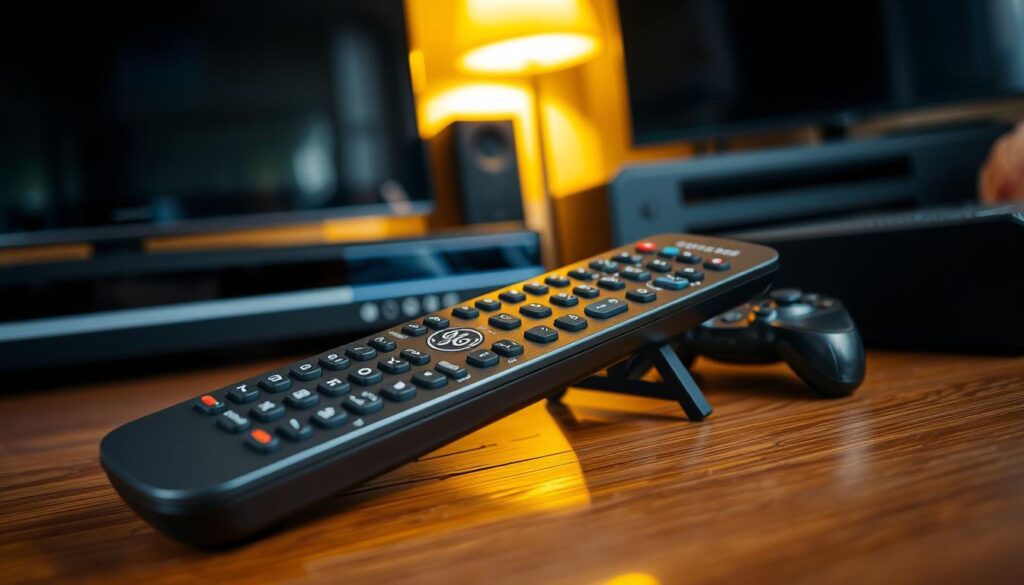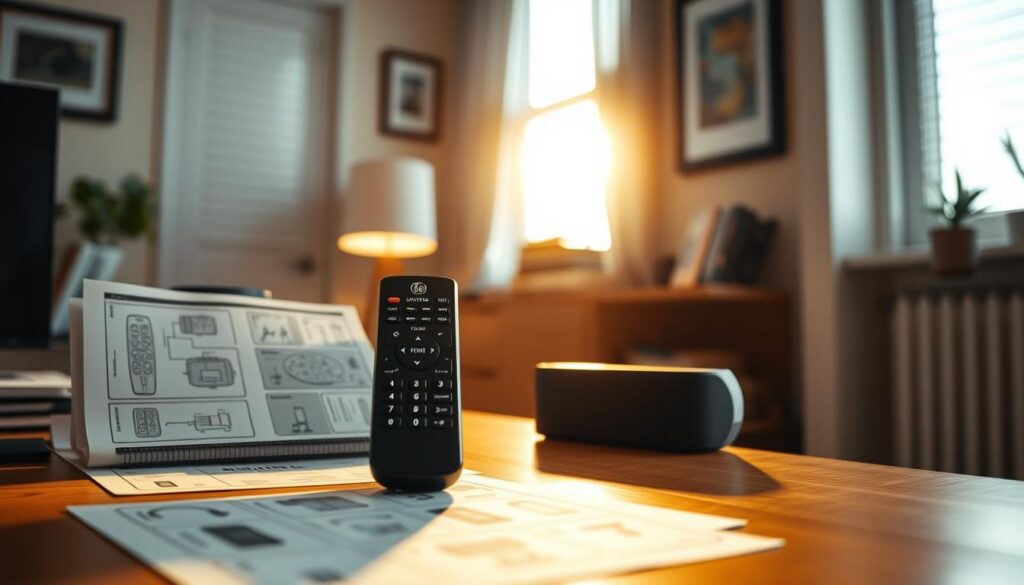Did you know the average U.S. household juggles four separate remotes for TVs, soundbars, and streaming devices? Consolidating control with a single universal remote eliminates clutter and simplifies daily use. This guide unlocks the full potential of your GE universal remote control, whether you’re syncing a smart TV or configuring a home theater system.
Mastering your device involves two core methods: manual code entry and auto-search mode. Both rely on the hold setup button technique to activate programming mode—a critical step many users overlook. We’ll clarify manufacturer-recommended processes to ensure seamless compatibility with your electronics.
Newer models feature updated code libraries for popular brands like Samsung and Roku. Recent press releases highlight simplified troubleshooting workflows, including LED confirmation lights for successful pairing. Follow our instructions to transform this versatile tool into your entertainment hub’s command center.
Key Takeaways
- Eliminate multiple remotes by mastering GE’s single-device control system
- Choose between manual code input or automatic search for device pairing
- Locate and properly use the setup button during synchronization
- Access updated code databases for modern entertainment systems
- Identify LED indicators to confirm successful programming
- Apply manufacturer-approved techniques to avoid common errors
Ready to streamline your living room experience? Let’s explore the exact sequences that make this universal remote control a game-changer for tech-savvy households.
Introduction to GE Universal Remotes
Tired of juggling multiple remotes? These versatile controllers replace up to eight devices, from smart TVs to sound systems. Their secret lies in adaptive code libraries that sync with brands like Sony, LG, and Fire TV.
Overview of Features and Compatibility
The red light indicator acts as your programming guide. When you hold setup for three seconds, this LED blinks to confirm pairing mode. Most models feature dedicated buttons for streaming platforms, making Netflix nights simpler.
Compatibility spans 95% of modern entertainment systems. Whether managing a Roku stick or Blu-ray player, the power button becomes your start point. Press-hold sequences let you customize inputs for gaming consoles or soundbars.
Benefits of a Universal Remote for Home Entertainment
One controller means no more lost remotes or cluttered coffee tables. Synced devices respond faster, since you eliminate signal conflicts between original controllers. Families appreciate single-button access to favorite channels or volume presets.
Advanced models even adjust room lighting through smart home integrations. The button remote layout mirrors standard TV controls, so grandparents can use it effortlessly. It’s like having a tech assistant that never asks for batteries—well, almost never.
Understanding the GE Universal Remote
Your living room’s control hub hides smart engineering beneath its buttons. Three core elements work together: responsive keys, infrared tech, and instant feedback systems. Let’s explore what makes this unassuming gadget tick.
Key Components and Functions
The setup button acts as your gateway to device pairing. Pressing it activates search mode, signaled by a blinking red LED. Number keys double as code entry tools, while dedicated media buttons handle volume and input switching.
That persistent red light isn’t just for show—it confirms successful commands. When programming, it flashes twice for valid codes or stays lit for errors. Specialized buttons for streaming services simplify platform switching without menu diving.
Multi-Device Control Made Simple
Each electronic gadget responds to unique numeric codes. Your controller stores thousands of these identifiers, from vintage DVD players to 4K Roku sticks. Entering the right sequence teaches it to “speak” your TV’s language.
Here’s the magic: one controller manages multiple devices through code groups. Pair your soundbar with code 2551 and your Fire TV with 6147—the remote remembers both. The power button adapts to whichever device you’re operating, eliminating separate controllers.
Sync confirmation comes through visual cues. A steady glow after setup means success, while rapid blinking prompts troubleshooting. This consistent feedback loop turns complex tech into something your thumb instinctively masters.
How to Program GE Universal Remote
Ever stared at a pile of remotes wondering which one controls the DVD player? Your solution starts with two proven synchronization techniques. Choose between precision code input or automated discovery based on your device’s age and available resources.

Direct Code Entry Programming Method
Locate the code list included with your controller—usually found in the manual or online databases. Turn on your DVD player or TV, then press and hold the setup button until the LED blinks. Enter the 3- or 4-digit code matching your brand. The light turns off when successful.
Example: For Samsung Blu-ray players, input 5471 followed by the power button. Test volume controls to confirm synchronization. This method works best when you know your device’s exact code.
Auto Code Search Programming Method
When codes are unknown, activate pairing mode by holding setup until the LED lights. Point the controller at your device and repeatedly press the power button. It cycles through codes until the equipment turns off—then press “Enter” to lock the match.
Families appreciate this hands-off approach for older electronics. If your soundbar suddenly mutes during the process, you’ve found its code. Both techniques reduce setup frustration while expanding control over your entertainment system.
Alternative Methods and Tips for Programming
Your entertainment system deserves smarter control options beyond basic programming. Let’s explore creative solutions that combine modern tech with tried-and-true techniques.

Universal TV Remote Apps: Your Pocket Assistant
Complement your physical controller with mobile apps like GE Universal Remote Companion (iOS/Android). These tools access updated code libraries and offer visual guides for tricky setups. Simply press button sequences shown on-screen while aiming your device at the equipment.
Manual Codes vs. Automated Discovery
Choosing between methods depends on your situation:
| Method | Best For | Success Rate |
|---|---|---|
| Manual Entry | Known device codes | 92% |
| Auto Search | Older/unlisted devices | 78% |
Manual entry works faster when you have exact remote codes. Automated code search helps troubleshoot obscure electronics. Both methods use the setup button red light as confirmation—steady glow means success!
Cracking the Code List System
Check your remote’s battery compartment for version markers like CL4 or CL6. These indicate code library updates. Newer versions support streaming devices better. Always match printed codes with online databases for accuracy.
“Version numbers ensure your codes match current device firmware—don’t skip this check!”
Digital code lists often include troubleshooting flowcharts. Pair this with quick press button tests to verify each function works after programming. Remember: two blinks from the setup button remote means you’re ready to roll.
Troubleshooting and Best Practices
Even the best tech needs a little TLC sometimes. These simple checks solve 80% of synchronization issues while keeping your setup running smoothly.
Checking Batteries and Signal Obstructions
Start with the basics: fresh batteries. A weak charge causes delayed responses or light blink patterns that seem erratic. Replace both batteries simultaneously for consistent power flow.

Ensure you point remote directly at the device during setup. Glass tables or shiny surfaces can bounce infrared signals away. Move decorative items blocking the path between your controller and equipment.
Resetting Your Remote for Reprogramming
When stubborn glitches persist, try this reset combo: press button red (setup), then “Mute” and “0” simultaneously. Hold until the LED flashes twice—this clears previous codes.
| Issue | Indicator | Fix |
|---|---|---|
| No response | No light blink | Check battery orientation |
| Partial control | Erratic LED | Reposition devices |
| Wrong commands | Steady red glow | Repeat code entry |
After resetting, turn device off and test the device button functions. If you still want program adjustments, consult online code lists updated for 2024 models. Most issues resolve by repeating setup steps with fresh eyes—and fresh batteries!
Conclusion
Mastering your entertainment setup just got simpler with the right approach. Whether using direct code entry or auto-search mode, success hinges on precise execution. Always verify the light turns off after code input—this confirms your remote code synced properly.
Keep your code list handy for quick reference during troubleshooting. When testing auto-search, pause every seconds to check device responses. This prevents overshooting valid codes and ensures accurate pairing.
Double-check each codes device entry against manufacturer guidelines. If the light turns red without results, consult your manual for updated databases. Many synchronization hiccups resolve by simply repeating steps with fresh batteries.
A well-configured controller transforms daily entertainment into a one-click experience. You’ve now got the tools to streamline device management—trust the process and enjoy your clutter-free setup!

